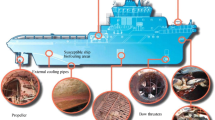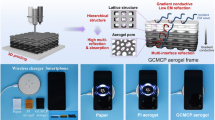Abstract
Detecting/sensing targets underwater has very important applications in environmental study, civil engineering and national security. In this paper, an organic-film based triboelectric nanogenerator (TENG) has been successfully demonstrated for the first time as a self-powered and high sensitivity acoustic sensor to detect underwater targets at low frequencies around 100 Hz. This innovative, cost-effective, simple-design TENG consists of a thin-film-based Cu electrode and a polytetrafluoroethylene (PTFE) film with nanostructures on its surfaces. On the basis of the coupling effect between triboelectrification and electrostatic induction, the sensor generates electrical output signals in response to incident sound waves. Operating at a resonance frequency of 110 Hz, under an acoustic pressure of 144.2 dBSPL, the maximum open-circuit voltage and short-circuit current of the generator can respectively reach 65 V and 32 μA underwater. The directional dependence pattern has a bi-directional shape with a total response angle of 60°. Its sensitivity is higher than −185 dB in the frequency range from 30 Hz to 200 Hz. The highest sensitivity is −146 dB at resonance frequency. The three-dimensional coordinates of an acoustic source were identified by four TENGs, self-powered active sensors, and the location of the acoustic source was determined with an error about 0.2 m. This study not only expands the application fields of TENGs from the atmosphere to water, but also shows the TENG is a promising acoustic source locator in underwater environments.

Similar content being viewed by others
References
Wang, Z. L.; Song, J. Piezoelectric nanogenerators based on zinc oxide nanowire arrays. Science 2006, 312, 242–246.
Wang, Z. L. Self-powered nanosensors and nanosystems. Adv. Mater. 2012, 24, 280–285.
Xu, S.; Qin, Y.; Xu, C.; Wei, Y.; Yang, R.; Wang, Z. L. Self-powered nanowire devices. Nat. Nanotechnol. 2010, 5, 366–373.
Yang, Y.; Lin, Z. H.; Hou, T.; Zhang, F.; Wang, Z. L. Nanowire-composite based flexible thermoelectric nanogenerators and self-powered temperature sensors. Nano Res. 2012, 5, 888–895.
Katz, E.; Buckmann, A. F.; Willner, I. Self-powered enzyme-based biosensors. J. Am. Chem. Soc. 2001, 123, 10752–10753.
Wen, D.; Deng, L.; Guo, S.; Dong, S. Self-powered sensor for trace Hg2+ detection. Anal. Chem. 2011, 83, 3968–3972.
Yu, A.; Jiang, P.; Wang, Z. L. Nanogenerator as self-powered vibration sensor. Nano Energ. 2012, 1, 418–423.
Wang, Z. L. Self-powered nanotech. Sci. Am. 2008, 298, 82–87.
Akyildiz, I. F.; Jornet, J. M. Electromagnetic wireless nanosensor networks. Nano Commun. Networks 2010, 1, 3–19.
Fan, F. R.; Tian, Z. Q.; Wang, Z. L. Flexible triboelectric generator. Nano Energ. 2012, 1, 328–334.
Fan, F. R.; Lin, L.; Zhu, G.; Wu, W.; Zhang, R.; Wang, Z. L. Transparent triboelectric nanogenerators and self-powered pressure sensors based on micropatterned plastic films. Nano Lett. 2012, 12, 3109–3114.
Lin, L.; Xie, Y. N.; Wang, S. H.; Wu, W. Z.; Niu, S. M.; Wen, X. N.; Wang, Z. L. Triboelectric active sensor array for self-powered static and dynamic pressure detection and tactile imaging. ACS Nano 2013, 7, 8266–8274.
Chen, J.; Zhu, G.; Yang, W. Q.; Jing, Q. S.; Bai, P.; Yang, Y.; Hou, T. C.; Wang, Z. L. Harmonic-resonator-based triboelectric nanogenerator as a sustainable power source and a self-powered active vibration sensor. Adv. Mater. 2013, 25, 6094–6099.
Lin, Z. H.; Zhu, G.; Zhou, Y. S.; Yang, Y.; Bai, P.; Chen, J.; Wang, Z. L. A self-powered triboelectric nanosensor for mercury ion detection. Angew. Chem. Int. Ed. 2013, 52, 5065–5069.
Yang, J.; Chen, J.; Liu, Y.; Yang, W. Q.; Su, Y. J.; Wang, Z. L. Triboelectrification-based organic film nanogenerator for acoustic energy harvesting and self-powered active acoustic sensing. ACS Nano 2014, 8, 2649–2657.
Zhang, H.; Yang, Y.; Su, Y.; Chen, J.; Adams, K.; Lee, S.; Hu, C.; Wang, Z. L. Triboelectric nanogenerator for harvesting vibration energy in full space and as self-powered acceleration sensor. Adv. Funct. Mater. 2014, 24, 1401–1407.
Decarpigny, J. N.; Hamonic, B.; Wilson Jr, O. B. The design of low frequency underwater acoustic projectors: Present status and future trends. IEEE J. Oceanic Eng. 1991, 16, 107–122.
Fukada, E. History and recent progress in piezoelectric polymers. IEEE T. Ultrason. Ferr. 2000, 47, 1277–1290.
Bucaro, J.; Dardy, H.; Carome, E. Fiber optic hydrophone. J. Acoust. Soc. Am. 1977, 62, 1302–1304.
Niu, S.; Wang, S.; Lin, L.; Liu, Y.; Zhou, Y. S.; Hu, Y.; Wang, Z. L. Theoretical study of contact-mode triboelectric nanogenerators as an effective power source. Energ. Environ. Sci. 2013, 6, 3576–3583.
Kundu, T. Acoustic source localization. Ultrasonics 2014, 54, 25–38.
Author information
Authors and Affiliations
Corresponding authors
Additional information
Authors with equal contribution and authorship order determined by coin toss.
Electronic supplementary material
Rights and permissions
About this article
Cite this article
Yu, A., Song, M., Zhang, Y. et al. Self-powered acoustic source locator in underwater environment based on organic film triboelectric nanogenerator. Nano Res. 8, 765–773 (2015). https://doi.org/10.1007/s12274-014-0559-z
Received:
Revised:
Accepted:
Published:
Issue Date:
DOI: https://doi.org/10.1007/s12274-014-0559-z




